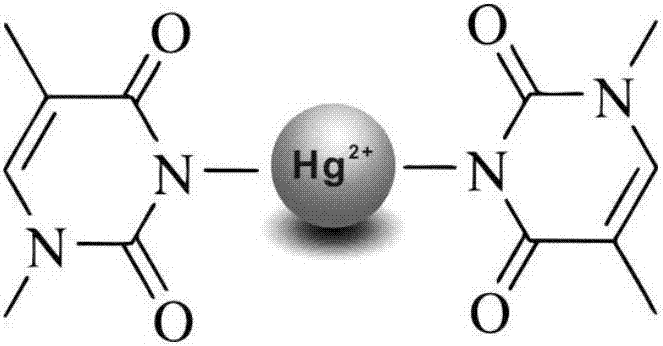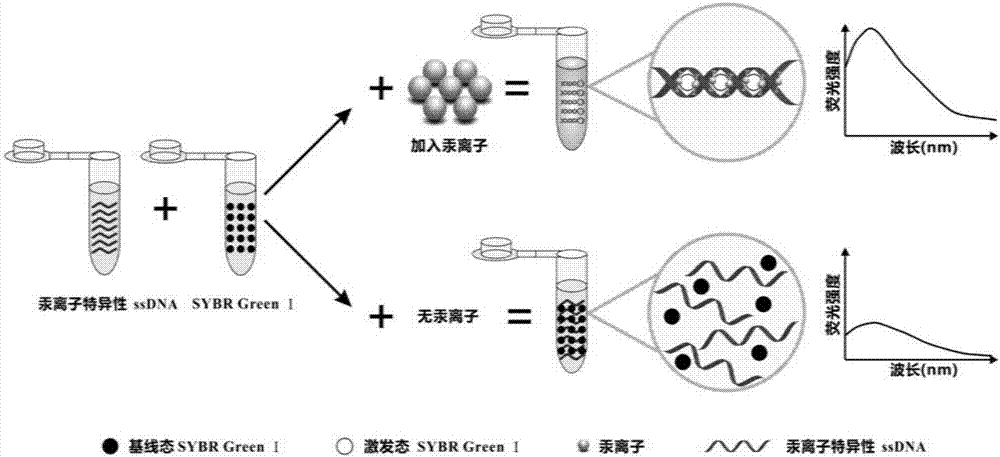On-step type label-free rapid fluorescence mercury ion detection method
A label-free, mercury ion technology, applied in the field of fluorescence detection, can solve the problems of limited wide application, large sample volume professional training, etc., and achieve the effect of sensitive method
- Summary
- Abstract
- Description
- Claims
- Application Information
AI Technical Summary
Problems solved by technology
Method used
Image
Examples
Embodiment 1
[0023] 1 Experimental method
[0024] 1.1 Reagents and materials ssDNA was designed by Mfold (http: / / unafold.rna.albany.edu / ?q=mfold / DNA-Folding-Form), synthesized by Sangon (Shanghai, China), and purified by high-performance liquid chromatography . The sequence of the mercury-specific ssDNA is: 5'-CTTCTTTCTTCCCCTTGTTTGTTG-3' (shown in SEQ ID NO.1). SG I (10,000×) was purchased from Invitrogen Biotechnology Co., Ltd (Shanghai, China) and stored at -20°C.
[0025] Hg 2+ , Pb 2+ , Ni 2+ , Zn 2+ , Ca 2+ , Cu 2+ , Fe 3+ , Cr 6+ and Cd 2+ The standard solutions were purchased from AccuStandard, Inc. (New Haven, USA), and the concentrations were 1mg mL -1 . The rest of the chemicals were analytically pure. The experimental water was ultrapure water. All experimental operations were performed at room temperature.
[0026] 1.2 Instrument fluorescence intensity (FIs) is measured by F-4500 fluorescence spectrophotometer (Hitachi, Japan), the measurement parameters are as ...
Embodiment 2
[0050] A one-step method for label-free fluorescence rapid detection of mercury ions, comprising the following steps:
[0051] (1) Add 200 μL of 100 nM mercury-specific ssDNA solution and 2 μL of 100× SG I fluorescent dye diluted with water to 6 centrifuge tubes, and then add 50 μL of 6 Hg selected from 5-1000 nM in a gradient. 2+ Aqueous solution, respectively 5, 20, 100, 400, 800 and 1000nM, mix well and incubate at room temperature for 0.5min;
[0052] (2) Using a fluorescence spectrophotometer, with 490nm as the excitation wavelength, the liquid obtained in step (1) is scanned at an emission wavelength of 535nm to obtain respective fluorescence intensity values, and prepare a fluorescence intensity response standard curve;
[0053] (3) Take 4 centrifuge tubes again, add 200 μL of 100 nM mercury-specific ssDNA solution and 2 μL of 100× SG I fluorescent dye diluted with water, then add 50 μL of the water sample to be tested filtered through a 0.45 μm microporous membrane, mi...
Embodiment 3
[0055] A one-step method for label-free fluorescence rapid detection of mercury ions, comprising the following steps:
[0056] (1) Add 200 μL of 100 nM Hg-specific ssDNA solution and 2 μL of 100× SGI fluorescent dye diluted with water to 8 centrifuge tubes, and then add 50 μL of 8 Hg selected from 5-1000 nM in a gradient. 2+ Aqueous solutions, respectively 5, 10, 20, 80, 160, 320, 640 and 1000nM, mix well and incubate at room temperature for 3min;
[0057] (2) Using a fluorescence spectrophotometer, with 490nm as the excitation wavelength, the liquid obtained in step (1) is scanned at an emission wavelength of 535nm to obtain respective fluorescence intensity values, and prepare a fluorescence intensity response standard curve;
[0058] (3) Take 5 centrifuge tubes again, add 200 μL of 100 nM mercury-specific ssDNA solution and 2 μL of 100× SG I fluorescent dye diluted with water, then add 50 μL of the water sample to be tested filtered through a 0.45 μm microporous membrane, m...
PUM
 Login to View More
Login to View More Abstract
Description
Claims
Application Information
 Login to View More
Login to View More - R&D
- Intellectual Property
- Life Sciences
- Materials
- Tech Scout
- Unparalleled Data Quality
- Higher Quality Content
- 60% Fewer Hallucinations
Browse by: Latest US Patents, China's latest patents, Technical Efficacy Thesaurus, Application Domain, Technology Topic, Popular Technical Reports.
© 2025 PatSnap. All rights reserved.Legal|Privacy policy|Modern Slavery Act Transparency Statement|Sitemap|About US| Contact US: help@patsnap.com



